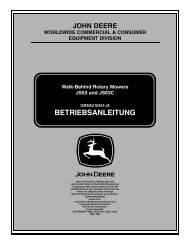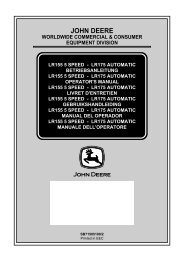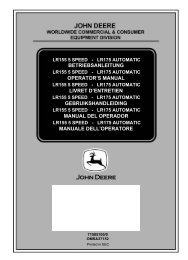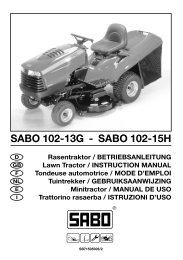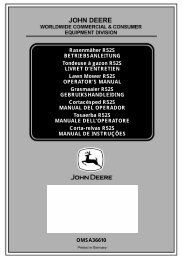dB - Operator's Manual - John Deere
dB - Operator's Manual - John Deere
dB - Operator's Manual - John Deere
You also want an ePaper? Increase the reach of your titles
YUMPU automatically turns print PDFs into web optimized ePapers that Google loves.
24 EN<br />
HOW TO USE THE MACHINE<br />
Hydrostatic transmission<br />
Move on slopes with the speed change lever in the «N» position, (to take advantage<br />
of the hydrostatic unit's braking effect) and then further reduce the speed using the<br />
brake, if necessary.<br />
DANGER! Never use reverse for reducing speed going downhill.<br />
Control of the machine could be lost, particularly on slippery surfaces.<br />
5.3.5 Emptying the grass-catcher<br />
NOTE This operation can only be done with<br />
the blade disengaged, otherwise the engine stops.<br />
When the grass-catcher is full an audible warning is given.<br />
STOP FORWARD MOVEMENT, in order not to block the<br />
collector channel, and disengage the blade which will<br />
stop the audible signal.<br />
Empty the grass-catcher by lifting it using the handle.<br />
NOTE At times the audible warning may be<br />
heard on engaging the blade even when the grasscatcher<br />
has been emptied. This is due to grass cuttings left on the sensor of the micro-switch.<br />
To stop the signal, either remove the remaining grass or disengage the<br />
blade and then immediately engage it again.<br />
5.3.6 Emptying the collector channel<br />
Cutting very tall or wet grass, particularly at too high a speed, can cause the collector<br />
channel to become blocked. Should this happen, it will be necessary to:<br />
– stop forward movement, disengage the blade and stop the engine;<br />
– take off the grass-catcher or stone-guard;<br />
– remove the accumulated cuttings going in through the exit of the collector channel.<br />
WARNING!<br />
This must only be done when the engine is stopped.<br />
5.3.7 Summary of the main conditions whereby the safety devices<br />
permit or stop work<br />
The safety devices work in two ways:<br />
– by preventing the engine from starting if all the safety requirements have not been<br />
met;<br />
– stopping the engine if even just one of the safety requirements is lacking.



